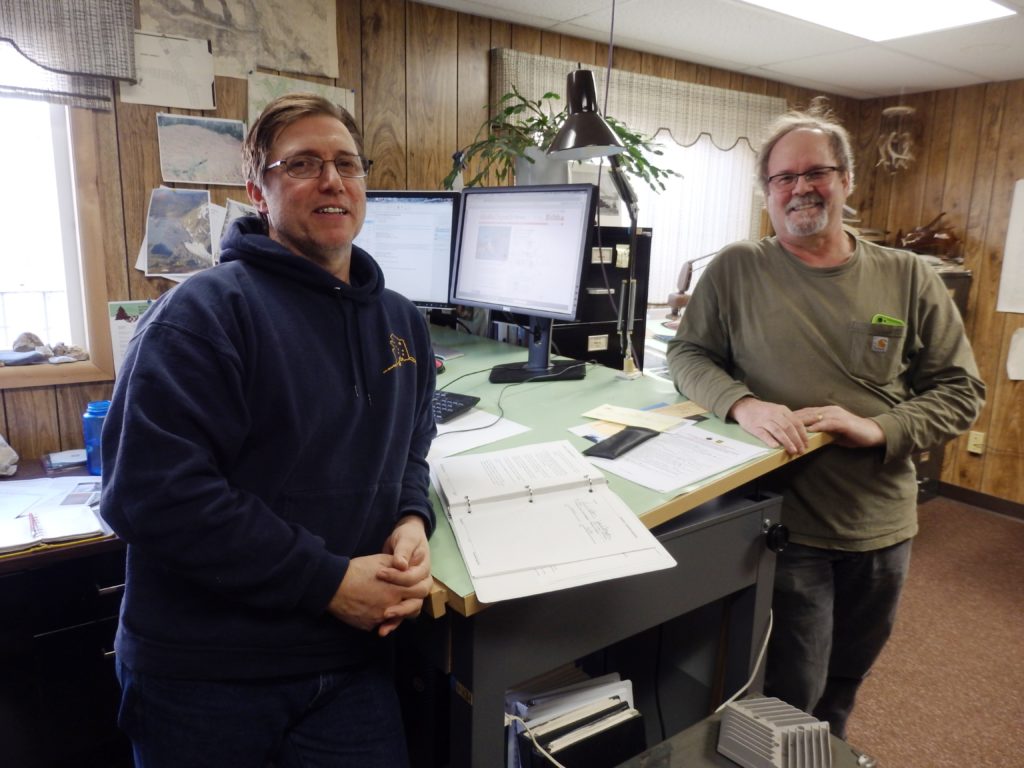
Greg Palmieri and Roy Josephson are Haines state foresters. (Emily Files)
The Haines State Forestry office opened back up for local business Tuesday. And if you stop by, you might be surprised to see two foresters at work. That’s thanks to a federal project in the Tongass National Forest. But even though the office is back to pre-budget-crisis staffing levels, it’s not all good news. Funding and time for local, Haines State Forest business, is limited and tenuous.
Foresters Greg Palmieri and Roy Josephson are both back to work.
“I mean it kind of came out of the blue but I guess I’m a little surprised to be back here,” said Josephson.
He lost his job and retired last year when the state legislature zeroed out funding for the Haines forestry office. The department was able to piece together money to keep Palmieri on for about nine months of the year, but not enough to employ them both.
The office was shuttered from late November to March 1. Here’s Palmieri.
“I’m glad that the door’s open again,” Palmieri said.
Combined, Palmieri and Josephson have about 50 years of experience as state foresters. They were two of more than 20 forestry staff whose jobs were eliminated in state budget cuts last year. Director of Forestry Chris Maisch says the division isn’t facing those kind of reductions this budget cycle, yet.
“Haines is still, well I guess I could say status quo,” Maisch said. “Which, it was unfunded last year so it still means I have to find other funds in the division to keep the office staffed.”
Maisch says a lot of the Haines staff’s time will be redirected from local services to a federal project. Josephson’s position is now completely federally-focused. He is the Southeast project manager for a Tongass second-growth inventory effort. Crews of foresters will catalog 35,000 acres of the Tongass in the next year or two. It’s part of the U.S. Forest Service’s plan to switch logging from old-growth to second-growth timber.
“And we’ll go and measure the trees, essentially, and we’ll gather other data on wildlife and vegetation and streams, how can we log this site, what’s the access,” Josephson said. “So we’re going to cover every square inch of this 35,000 acres. It’s an extensive project.”
Josephson says it was a difficult choice to take on this project. That’s because he’s going to be out of town a lot. The stretches of forest that need to inventoried are mainly in Southern Southeast – including Price of Wales Island, Kake, and Wrangell. He says he’ll be gone most of the summer. But there is an upside.
“I like walking in the woods, which this is gonna be. Lots of walking in the woods.”
Palmieri will also spend a lot of time on the Tongass project, meaning he’ll be out of the office for days or weeks at a time. He says how much time could depend on what timber sales happen in Haines.
“Depending on the level of timber sale activity, the need to be here can be prioritized,” Palmieri said. “The local operators, I should be able to handle irregardless of whether or not I need to travel for some period of time and spend a month with Roy working on this project or not. The real issue will be prioritization if the bigger sales are moving forward.”
By bigger sales, he’s mostly referring to the 855-acre Baby Brown Timber Sale. That spread of old growth spruce and hemlock along the Klehini River will be put to bid this spring. Conservation groups appealed the final best interest finding for the sale, but their appeal was not upheld by the Department of Natural Resources Commissioner. Baby Brown is the largest positional timber sale in the Haines State Forest in 20 years.
Forestry Director Maisch says revenue from a large sale would help keep the local office open. In the meantime, the Tongass Project is ‘buying time’ for his department to look at other solutions to keep up funding for the Haines office.
“It’s a dynamic situation, so things change pretty quickly sometimes,” Maisch said. “We’ve got a long time to go still in this current [legislative] session.”
Palmieri says he’s gotten better at coping with the uncertainty.
“I can’t do anything but continue to move forward the best I can.”
He says he still hopes that the legislature could recognize this office needs to stay open.









